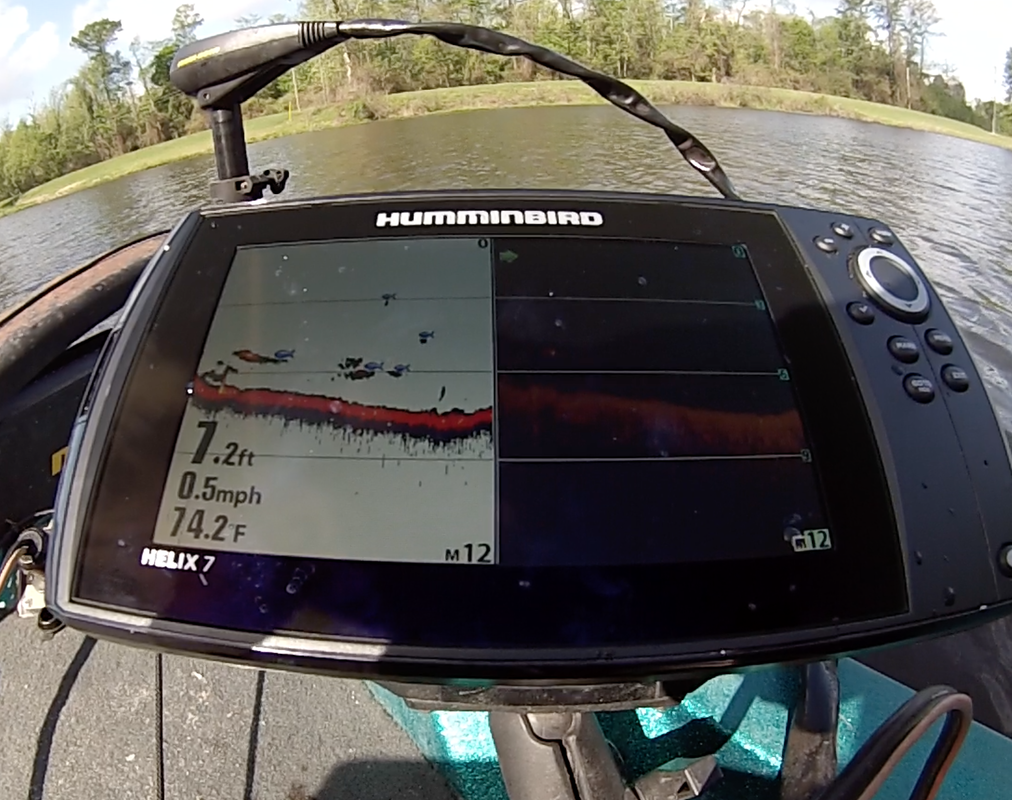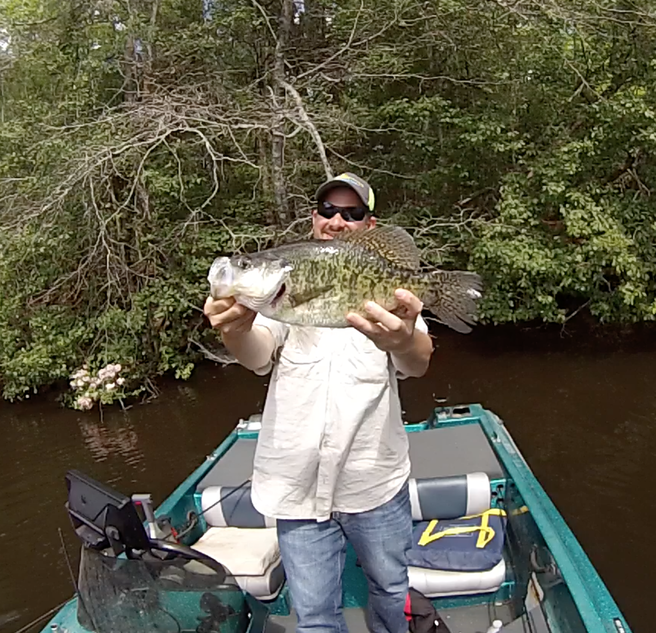 Keith Lusher
Keith Lusher In the world of sac-a-lait fishing, there is one sought after trait in a fishing rod that all anglers will agree is important to catching more fish. That trait is sensitivity. Sac-a-lait are unarguably the most subtle biting fish that an angler can target here on the North Shore of Lake Pontchartrain. They are known to hide in submerged branches and underneath tree trunks that line the rivers and bayous and often suspend at depths that most fisherman never attempt to fish. The anglers that target them are a rare breed and the rods they use are the most important tools in their arsenal of equipment.
I witnessed this first hand when I recently made a fishing trip with a gentleman that is one of the best crappie fisherman on the North Shore. John Guillot lives in Kiln, Mississippi and fishes the Pearl River Navigational Canal between Lock #1 and Lock #2. I met John at the boat launch on Lock #1 Road and upon entering his boat noticed what looked like fly rods in the holders that spanned the entire side of his boat.
I witnessed this first hand when I recently made a fishing trip with a gentleman that is one of the best crappie fisherman on the North Shore. John Guillot lives in Kiln, Mississippi and fishes the Pearl River Navigational Canal between Lock #1 and Lock #2. I met John at the boat launch on Lock #1 Road and upon entering his boat noticed what looked like fly rods in the holders that spanned the entire side of his boat.
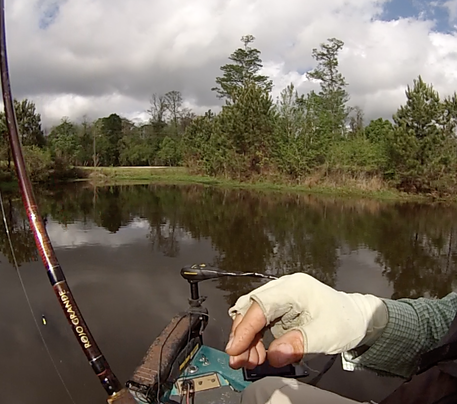 John fixes a black and chartreuse skirt to his jighead before making his first cast
John fixes a black and chartreuse skirt to his jighead before making his first cast I pointed them out and he confirmed that they indeed were fly rods. 9’ graphite saltwater poles strung with fluorescent yellow monofilament line that ended with a 2’ leader of clear mono filament line. As John opened up the engine and headed north of Lock #1, my attention went from the poles to the amount of boats fishing near the shoreline. John pointed their way and shook his head. “They're fishing too shallow, those fish are deeper,” he shouted over his wining 90 Yamaha. We passed the cluster of boats and settled near a stretch of shoreline that was peppered with fallen trees. John dropped the trolling motor in the middle of the canal and used the quiet battery powered engine to slowly maneuver to his destination approximately 20’ from the shoreline.
He pointed at his Hummingbird and confidently pointed out all of the fish that were layered around a submerged treetop. “They’re here, we just need this sun to come out,” John said as he looked to the sky. “I’ve found that if we have sunlight and the suns bright, the fish are more active, they’re more aggressive, and there’s more baitfish. The brighter it is, the better the fishing out here,” he said. I reached down to grab my rod and John stopped me. He told me to use one of his.
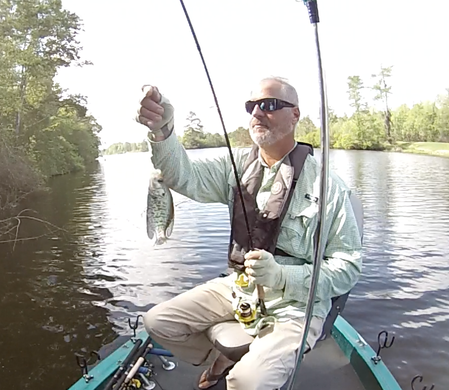 John slings a crappie in the boat that hit near the surface
John slings a crappie in the boat that hit near the surface I unhooked the black and chartreuse jig and lowered it into the water about 6’ down. I watched John lower his jig into the water but he only lowered it 2’ down. “What you want to do is lower it about 2’ down. What this does is it let’s the more aggressive fish have a chance to come up and strike the bait without disturbing the school. There may be 3 or 4 fish in that school that will come up and bite before I’m forced to put my lure down into the actual school of fish,” he said. As we both stood quiet I felt a few ticks on my line. I tried setting the hook but nothing was on the other end. John told me that I was feeing the fish swim by the line. “It’s incredible what you can feel with these rods and the new rod tips that I switched over to,” he added. He went on to explain how he ordered a new rod tip to replace a broken one on his Rojo Grande Fly Rod. They were thicker and fatter than what he thought he ordered and was first disappointed when he attached the new tip to the pole. “What started out as a mistake became a huge improvement. The tips are so small in diameter that there’s zero flex or deflection of the ring.
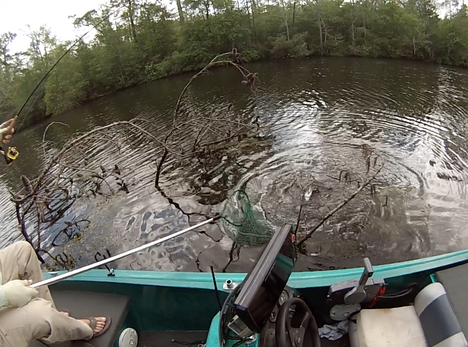 Guillot pulls a sac-a-lait from the branches before netting it.
Guillot pulls a sac-a-lait from the branches before netting it. The entire bite is transferred to the blank itself,” he said. We continued to fish and John picked up a small one but the sun was still blocked by the tree line. “Just wait. Wait till that sun peeks over those trees and into the water,” he excitedly whispered. We continued from tree to tree and right on cue, as the sun started shining on the spots we fished. We caught more fish. It wasn’t fast action by any means, but we picked up 4 or 5 fish on every tree. “You have to work at it. Most people come out here and if they don’t find them within an hour they think they’re not biting, but you just have to keeping working at it,” he stressed. As we worked down towards the camps on the canal we approached our final fallen tree. An old pine that’s canopy was half submerged. John said “I’ve pulled some real slabs from this spot. This trees got some monsters on it.” We eased in and started fishing. John snagged one and flipped a 9” fish into the boat. I started to get excited but what happened next will be permanently burned into my memory. I looked back and lowered my line into a 1’ opening between some branches. I lowered it 2’ down and left it there for about 12 seconds. I then lowered it down 5 more feet and felt an ever so subtle tap. I instinctively whipped the rod up and the rod drag “eeeeked” as if I set the hook on a log. I felt it pull back and knew I had something special. It didn't take long to see the fish as we were fishing near the boat, but when it surfaced John called out, “Your gonna need the net.” He grabbed the net and scooped the slab into the net. I unhooked the fish and held it up with two hands in amazement. John broke out the digital scale and hooked the fish on.
“2.11 lbs. That’s a slab right there!” John called out. It was the heaviest sac-a-lait I’ve ever caught. We ended the day soon after and counted up a total of 28 sac-a-liat. John says the bite at Lock #1 isn't over by any means. “These fish are still chock full of eggs, we’ve still got a long ways to go this month,” he adds.
